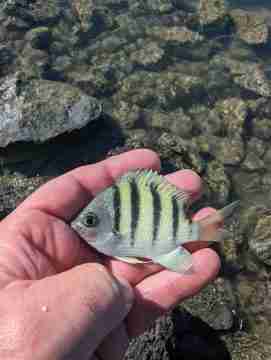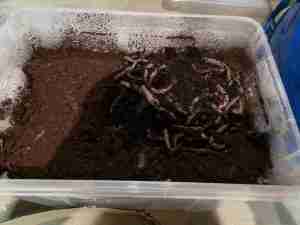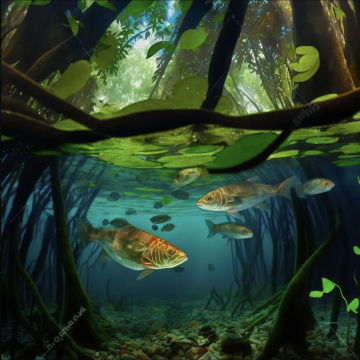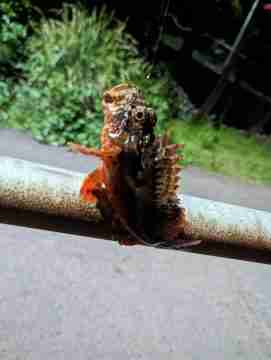Bringing the Wild to Your Aquarium: A Guide to Collecting & Keeping Micro Fish
Did you know some of the coolest fish for aquariums come straight from your backyard creek? If you’re into micro fishing you’ve probably already discovered the joy of catching native species but collecting them to keep at home opens up a whole new level of the hobby.
Whether you’re building a native microfish tank or just bringing home your first creek-caught darter this guide walks you through the dos, don’ts, and pro tips for collecting and caring for wild micro species.
Why I Started Collecting Native Micro Fish
Like many lifelong anglers I started collecting as a kid — pulling minnows, killifish, and shiners from the creek behind my house. Over time what began as backyard fun grew into one of the most rewarding parts of my micro fishing journey.
There’s something incredible about watching a fish you caught with a size #30 hook thrive in a carefully maintained aquarium. But keeping wild-caught fish healthy takes a bit of knowledge especially when it comes to diseases like bacterial fungus.
Is It Really Fungus? Let’s Break It Down
Most fish keepers call it “fungus,” but in reality, what you’re seeing on your fish might actually be a bacterial infection and not true fungus.
🧵 How to Tell the Difference:
-
True Fungus: Looks like cotton tufts glued to your fish. If it’s fuzzy and white and this is your culprit.
-
Bacterial Fungus: More common, and often mistaken for fungal infections, especially in stressed wild-caught fish.
🎯 How to Treat It:
-
True Fungus? Use methylene blue — it works fast and is easy to find.
-
Bacterial Infection? Use antibiotics that target gram-negative bacteria which are responsible for over 90% of fish-related illnesses.
👉 What’s Gram-Negative Mean?
It all goes back to Hans Christian Gram’s staining technique:
-
Gram-Positive bacteria have a thick cell wall.
-
Gram-Negative bacteria have a thinner wall but are usually more harmful to fish.
Most aquarium medications target gram-positive bacteria which won’t help your sick wild fish! That’s why choosing the right medication is critical.
Preventing Bacterial Infections in Aquarium Micro Fish
Instead of treating disease after it shows up your goal should be prevention. Wild fish are delicate and need extra care during collection, transport, and acclimation. It may not be the conditions but the shock in change of conditions.
✅ Pro Tips to Keep Your Collected Fish Healthy:
-
Keep Them Cool: Heat stresses fish out fast. Use insulated containers and change water frequently during transport.
-
Mimic Natural Conditions: Use natural creek water if possible. Avoid tap water even with dechlorinators as it can be deadly to micro fish.
-
Epsom Salts Help: Add 1 teaspoon per 5 gallons of water. This magnesium boost helps reduce stress and prevent internal issues.
-
Acclimate Slowly: Take your time adjusting your fish to new water chemistry and temperature. Rushing can kill even the hardiest species. Slow and steady is paramount. Slow and steady wins the race.
Best Micro Fish for Native Aquariums
Here’s a shortlist of native U.S. micro species that thrive in small aquariums:
| Species Name | Max Size | Notes |
|---|---|---|
| Least Killifish | 1″ | Perfect for nano tanks; livebearer |
| Bluefin Killifish | 1.5″ | Brilliant coloration; peaceful |
| Darters | 2-3″ | Require flow & cooler temps |
| Banded Killifish | 2.5″ | Active swimmers, need space |
| Pygmy Sunfish | 1″ | Elassoma species; shy but beautiful |
| Shiners | 2-4″ | Schooling behavior; active |
| Sculpins | 2-3″ | Bottom dwellers; need hiding spots |
| Dace | 2-3″ | Adaptable and fun to observe |
| Stonerollers | 3-4″ | Constant grazers; require algae or greens |
| Mosquitofish | 1.5″ | Hardy but aggressive breeders |
| Mad Toms | 2-3″ | Tiny catfish; nocturnal |
| Topminnows | 2-3″ | Surface feeders, ideal for planted tanks |
🧰 Gear for Collecting Micro Fish
Before you bring anything home, make sure you’re prepared. Here’s the recommended gear for collecting and keeping micro fish:
-
✅ Micro Master Size #30 Hooks – Catch tiny fish without injury
-
✅ Complete Micro Fishing Starter Kit – Perfect for collecting and beginner setups
-
✅ Ultra-Finesse Micro Floats – Detect the softest bites
-
✅ Fine-mesh dip net or seine net
-
✅ Insulated collection container with lid
-
✅ Battery-powered air pump for longer trips
💡 Quick Tips for Aquarium Setup
-
Use sand or fine gravel to mimic creek bottoms! Big box hardware stores have bags cheap. Rinse and use it.
-
Add rocks, driftwood, and native plants for shelter. Tie plants to rocks and driftwood.
-
Use a sponge filter to keep water clean without harming fry. It’s gentle and effective!
-
Keep the water between 68-74°F unless the species prefers colder!
Final Thoughts: Conservation First
When collecting wild fish always follow local regulations and take only what you can responsibly keep. Never release aquarium fish back into the wild as it’s dangerous for local ecosystems. Don’t let captive diseases spread by releasing fish!!!
Collecting native fish isn’t just fun! It’s educational and conservation-minded when done right.
🛒 Ready to Build Your Native Micro Fish Tank?
🎣 Start with the right gear and protect your fish from day one:
✅ Order Size #30 Hooks Now
✅ Shop the Complete Micro Fishing Starter Kit
✅ Grab Micro Floats for Finesse Fishing






